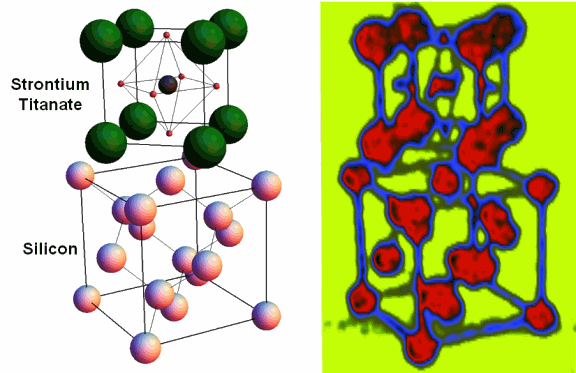The technology for storing electronic information—from the days of cassette tapes to today’s laptop computers—has been a major force in the electronics industry for decades. Improving this technology to keep up with new requirements and trends (faster, smaller, lighter, more powerful) has been an economic driver for as long as the technology has been around. Now, low-power, high-efficiency electronic memory could be the long-term result of collaborative research at the U.S. Department of Energy’s Advanced Photon Source (APS) at Argonne National Laboratory.
The research, published in the journal Science, involved taking a well-known oxide, strontium titanate, and depositing it on silicon in such a way that the silicon squeezes it into a special “ferroelectric” state. Ferroelectric materials are found in “smart cards” used in, for instance, subways and ski resorts. These credit-card-sized devices are made with such materials as lead zirconium titanate or strontium bismuth tantalate, which can instantly switch between different memory states using very little electric power. A tiny microwave antenna inside the card, when waved before a reader, reveals and updates stored information.
But a ferroelectric transistor would do for computing technology what ferroelectric materials have done for the smart-card industry. For more than half a century, scientists have wanted to use ferroelectric materials in transistors, which could lead to “instant-on” computing; no more rebooting the operating system or accessing memory slowly from the hard drive. No one has yet achieved a ferroelectric transistor that works.
“Adding new functionality to transistors can lead to improved computing and devices that have lower power and higher speed, and are more convenient to use,” said Darrell Schlom of Cornell University, corresponding author on the Science paper. “Several hybrid transistors have been proposed specifically with ferroelectrics in mind. By creating a ferroelectric directly on silicon, we are bringing this possibility closer to realization.”
Ordinarily, strontium titanate in its relaxed state is not ferroelectric at any temperature. The researchers have demonstrated, however, that extremely thin films of the oxide—just a few atoms thick—become ferroelectric when squeezed atom by atom to match the spacing between the atoms of underlying silicon. “Changing the spacing between atoms by about 1.7% drastically alters the properties of strontium titanate and turns it into a material with useful memory properties,” said Long-Qing Chen (The Pennsylvania State University), a member of the research team.
The researchers successfully grew the strontium titanate on top of silicon—the semiconductor found in virtually all electronic devices—using molecular-beam epitaxy, a technique akin to atomic spray-painting. “Developing the complex growth formalism of integrating high-quality strontium titanate films with silicon, which readily forms an unwanted amorphous interface, has depended upon many years of tinkering with the growth process in tandem with synchrotron-based structural and spectroscopic studies,” said co-author Philip Ryan, an Ames Laboratory scientist resident at Sector 6 at the Advanced Photon Source.
This work follows on from earlier studies initiated by co-author Hao Li from Motorola Corporation and led by team member Joseph Woicik, a National Institute of Standards and Technology researcher working at X-ray Operations and Research beamlines 6-ID and 33-BM the APS, and beamlines X23A2 and U7A at the National Synchrotron Light Source (Brookhaven National Laboratory)†. This work has brought the ability to engineer this structurally tentative system to the point where integrative functionalism between semiconductor technology and ferroelectricity may truly be possible.
Contact: D.G. Schlom, [email protected]
See: Maitri P. Warusawithana, Cheng Cen, Charles R. Sleasman, Joseph C. Woicik, Yulan Li, Lena Fitting Kourkoutis, Jeffrey A. Klug, Hao Li, Philip Ryan, Li-Peng Wang, Michael Bedzyk, David A. Muller, Long-Qing Chen, Jeremy Levy, and Darrell G. Schlom, “A Ferroelectric Oxide Made Directly on Silicon,” Science 324, 367 (17 April 2009).
†For more on this earlier work, see:
J.C. Woicik, E.L. Shirley, C.S. Hellberg, K.E. Andersen, S. Sambasivan, D.A. Fischer, B.D. Chapman, E.A. Stern, P. Ryan, D.L. Ederer, and H. Li, “Ferroelectric distortion in SrTiO3 thin films on Si(001) by x-ray absorption fine structure spectroscopy: Experiment and first-principles calculations,” Phys. Rev. B 75, 140103 (2007).
J.C. Woicik, H. Li, P. Zschack, E. Karapetrova, P. Ryan, C.R. Ashman, and C.S. Hellberg, “Anomalous lattice expansion of coherently strained SrTiO3 thin films grown on Si(001) by kinetically controlled sequential deposition,” Phys. Rev. B 73, 024112 (2006).
P. Ryan, D. Wermeille, J.W. Kim, J.C. Woicik, C.S. Hellberg, and H. Li, “Domain ordering of strained 5 ML SrTiO3 films on Si(001),” Appl. Phys. Lett. 90, 221908 (2007).
The original Cornell University press release can be found here.
This research was supported by Office of Naval Research grant N00014-04-1-0426 (M.P.W., L.F.K., D.A.M., and D.G.S.); National Science Foundation grants DMR-0507146 and DMR-0704022; and Materials Research Science and Engineering Center program grants DMR-0520404, DMR-0520513, and DMR-0820404.
Use of the Advanced Photon Source at Argonne National Laboratory was supported by the U.S. Department of Energy, Office of Science, Office of Basic Energy Sciences, under Contract No. DE-AC02-06CH11357.
Argonne National Laboratory seeks solutions to pressing national problems in science and technology. The nation's first national laboratory, Argonne conducts leading-edge basic and applied scientific research in virtually every scientific discipline. Argonne researchers work closely with researchers from hundreds of companies, universities, and federal, state and municipal agencies to help them solve their specific problems, advance America 's scientific leadership and prepare the nation for a better future. With employees from more than 60 nations, Argonne is managed by UChicago Argonne, LLC for the U.S. Department of Energy's Office of Science.

